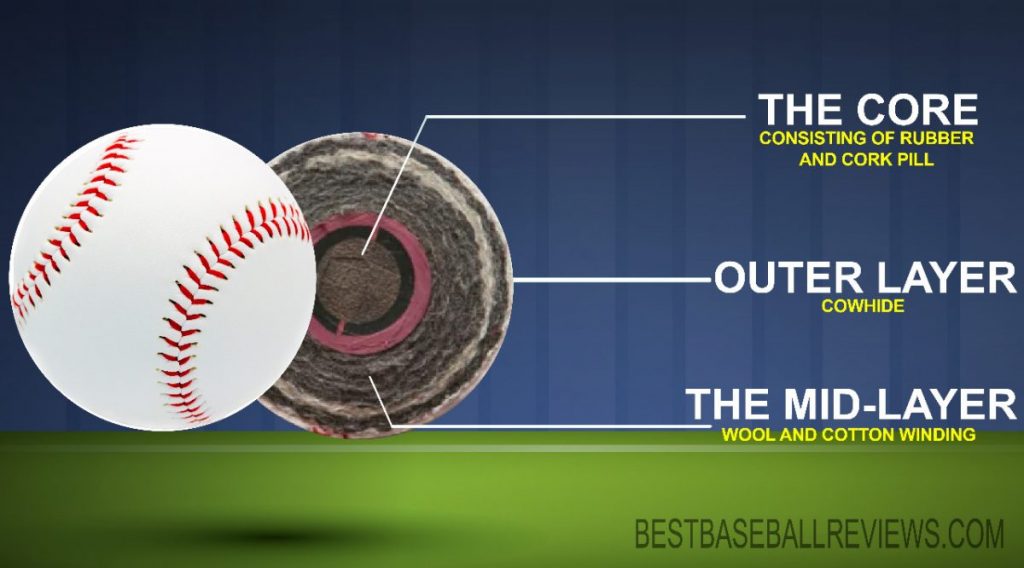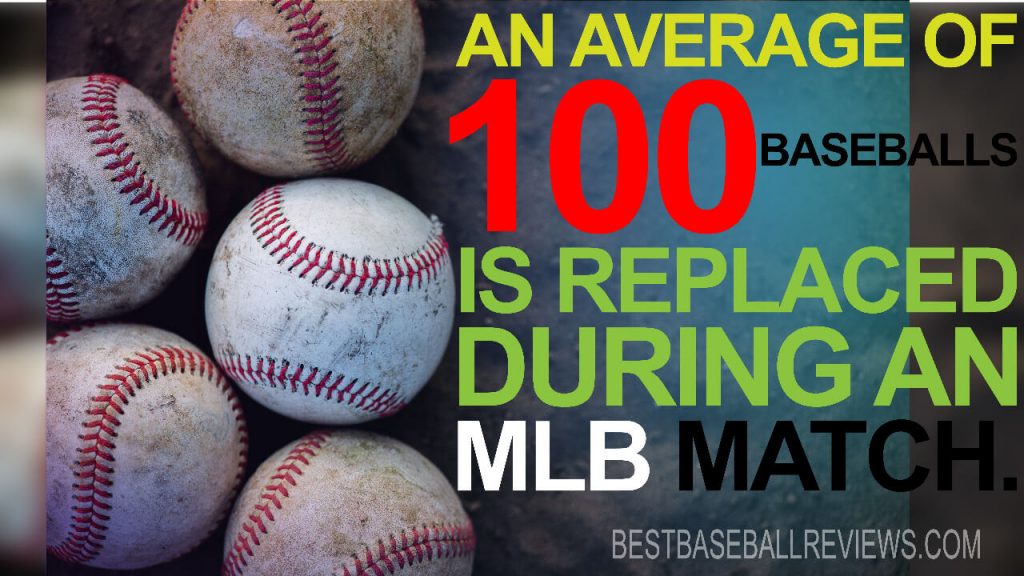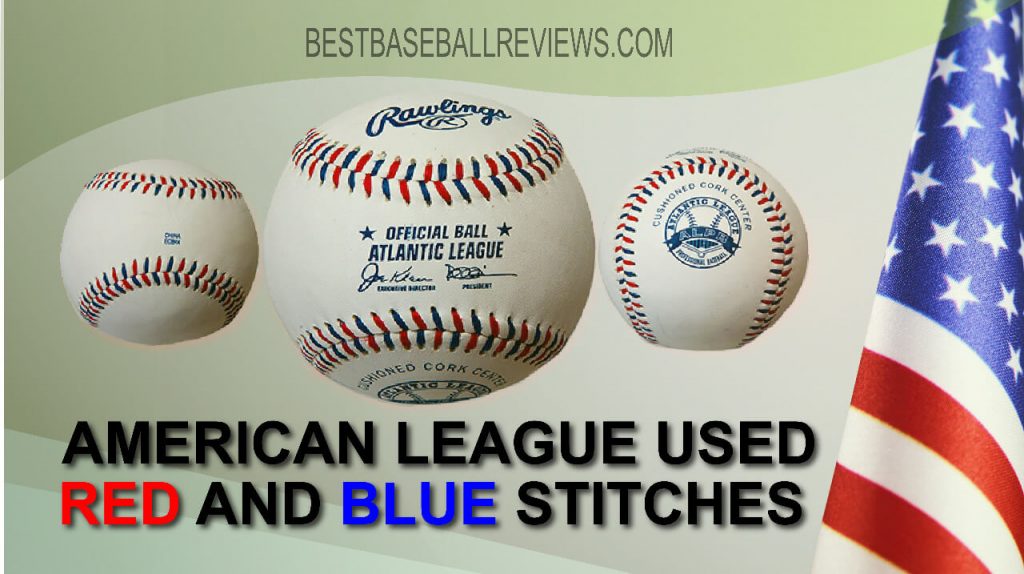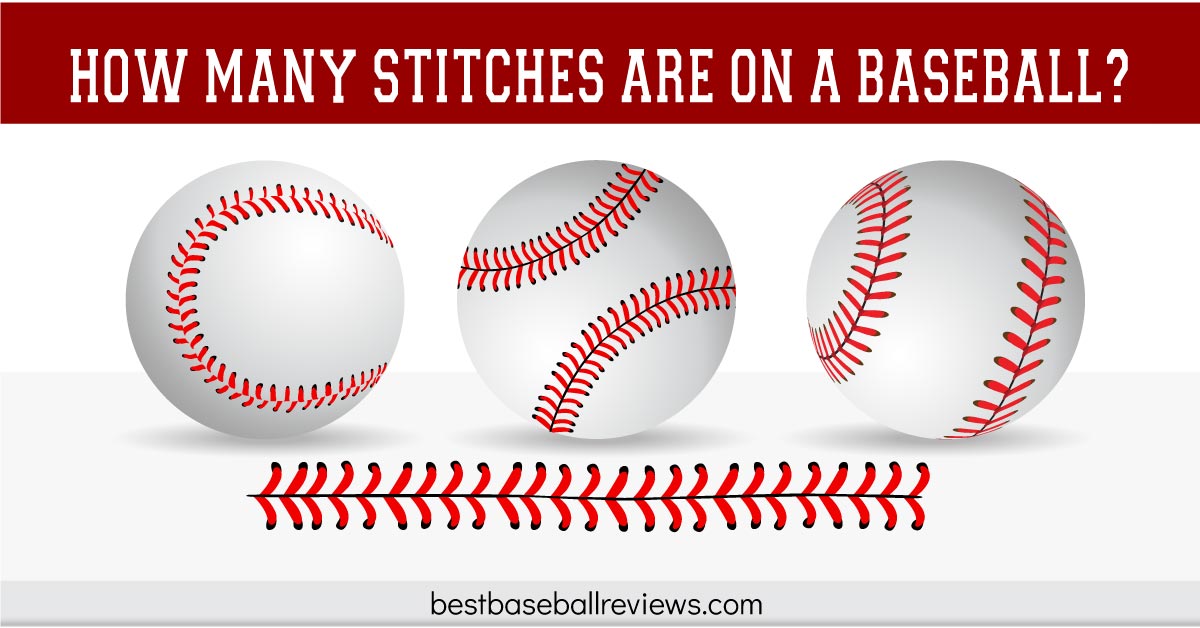A major league baseball (MLB) has 108 double stitches. Thus, the total number of single stitches is 216 in an official league baseball. The process of manufacturing a baseball entails several stages to get the perfect and uniform shape. Many baseball fans sometimes wonder, how many stitches are on a baseball? How a baseball is made? In this article, I am going to answer all these questions.
What Is Inside Of A Baseball?
There are three major parts of baseball. Manufacturing a baseball requires both manual and mechanical actions. Below are the components if we dissect a baseball.
- The core – consisting of rubber and cork pill
- The mid-layer – Wool and cotton winding
- Outer layer – cowhide
The pill of the baseball is spherical with a diameter of around 2 centimeters. The manufacturers make the pill with rubber and cork. The center of the pill consists of a cork. Also, there are two different layers of rubber around the cork. The color of the outer layer of the pill is red. Before winding threads on the pill, the workers at the factory pour adhesive on it so that the threads stick to pills properly.

The middle layer of the baseball has windings of wool and cotton. The manufacturers do the windings by rolling machines in different stages. The rolling machine winds with yarns in the below steps.
- A 4 ply gray wool yarn is the first winding loop.
- 3 ply white wool yarn is the second layer of winding.
- 3 ply gray wool yarn is the third layer of winding.
- Poly-wool blend makes the outermost layer.
Different layers of yarn give the baseball resilience. Therefore, the ball gets back to shape even if the batters hit it hard. We call the wound pill the center. While the winding is under process, a computer continuously weighs the ball to maintain the standard weight of each part of the ball. The factory workers add adhesive to the center before they put the cowhide leather on it.
Exterior Of A Baseball And The Stitches Of A Baseball
The exterior of the baseball is surrounded by two pieces of cowhide leather. Each of the pieces looks like the numeric 8 and it covers half of the surface area of the baseball. The workers attach each of the coverings by hand sewing. Baseball manufacturers avoid machine sewing or stapling to ensure the evenness of the balls. The worker dip the cowhides into a solution before the sewing process. It gives the hides smoothness which is important during hand sewing.
The workers use 88 inches of waxed red threads to sew the balls with cowhide. The required number of double stitches to sew the pieces of hides is 216. The workers keep the red stretches at a suitable temperature to maintain the MLB standard.
History Of Baseball Manufacturing & Baseball Stitching
1800s to 1900s
During the mid-1800s, baseballs were not uniform in shape and size. At that time, the manufacturers produced the baseballs from rubber core. They wrapped the core with two different layers made of yarn and leather. The baseball pitchers used to produce their own baseballs.
In the mid-1850s, there was an attempt to standardize baseballs. A baseball ball with more rubber and tighter winding was faster and traveled far away. On the other hand, a ball with less rubber and loose winding was called a ‘dead ball’. A dead ball did not travel a far way and it was slower. As the teams manufactured their own baseball, they often manipulated the game by taking this advantage. Therefore, it was decided that the weight of the ball would be 5.5 to 6 oz with a circumference ranging from 8 to 11 inches.
The year of formation of the National League (NL) is 1876. It adopted the standard of A.G Spalding, a baseball pitcher who used to manufacture his own baseball. NL continued this standard for baseball for around a century.
1900s to Present
In 1910, the manufacturers introduced the cork core that replaced the rubber core. The cork core balls were faster than rubber core balls. But the players gradually adopted it and it became normal.
In 1920, machine winding was introduced for the first time. The manufacturers imported a higher grade of yarn from Australia. Players and fans reported that baseball produced by this mechanical way was faster than before and helped the batter hit the ball further.
In 1934, National League and American League came to a consensus on the standard of baseball manufacturing. According to that standard, the manufacturers should make the core of the ball with cushion cork. Then there would be two layers of yarn wrapping. After that, another layer of rubber and two layers of yarn wrapping. Finally, the workers would make the outer layer by horsehide. Also, the baseball stitching standard was established.
In 1943, United States banned the usage of natural rubber for non-war purposes. Therefore, the manufacturers started using ‘balata’. It was a rubber-like substance that was extracted from a kind of tropical tree.
Just after one year, in 1944, synthetic rubber was invented. The manufacturers started using synthetic rubber cores instead of batata. It was a sigh of relief for the manufacturers as the ball made of balata was not up to the mark.
From 1974, baseball manufacturers started making the covers with cowhide instead of horsehide. Right after a couple of years, MLB switched their official baseball manufacturer to Rawlings.
Why Are The Baseballs Replaced During An MLB Match?
Baseballs are typically replaced in an official MLB or professional league baseball game for the following reasons:
- Damage or Wear: If a baseball becomes damaged, such as getting scuffed, cut, or significantly worn during play, it will be replaced. This is to ensure fair play and consistent ball flight.
- Lost or Unrecoverable: If a baseball is hit out of the playing area, lost in the stands, or unable to be retrieved during the game, it will be replaced with a new ball.
- Pitcher’s Request: Sometimes, pitchers may request a new ball if they feel that the current ball is not suitable for their grip or throwing preferences.
- Inning Changes: In professional baseball, new baseballs are often introduced at the beginning of each inning to maintain consistency and reduce potential advantages gained from altering the condition of the ball.
- Umpire’s Discretion: Umpires have the authority to replace a baseball if they determine it to be unfit for play due to excessive dirt, damage, or any other reason that may affect the integrity of the game.
The exact protocols for baseball replacement may vary slightly between different leagues and organizations, but these reasons generally apply to official MLB and professional league games.
When the ball comes in contact with in-field dirt or scratches, the trajectory of the ball changes. Thus, it creates unusual movement in the air. Therefore, a replacement becomes necessary.

Another reason for the frequent replacement of baseball is the discoloration of the ball over time. Sometimes the ball becomes difficult to see because of the dirt and discoloration. Back in 1920, a baseball player was hit in the head and died. Therefore, in recent times, the frequent swapping of the ball ensures the safety of the player and the fans by ensuring better visibility.
Why Are The Baseball Stitches Red?
There are a lot of guesses regarding the answer to this question. To find out the right answer let’s go back to the history of baseball stitching. In the 1900s, the colors of stitching in the American League and National League were different. American League used red and blue stitches while National League used black and red.
In 1934, MLB declared the baseball stitching standard. As per the league-wide standard, the color of the 108 double stitches was red. Red is the most visible color. Therefore, after the declaration of the baseball stitching standard, everyone accepted it. Similarly, the color of the glove of the pitcher should not be white as the visibility of white is the least. It ensured that the batter could see the approaching pitches conveniently.

Official Major League Baseball Manufacturer
As of 2021 hte offical manufacturer of Major League Baseball or MLB baseballs are the Rawlings Sporting Goods Company Inc.
Rawlings has been the official supplier of baseballs to MLB since 1977. Here are some details about the company:
- History and Legacy: Rawlings is a well-established sporting goods company with a long history in baseball. It was founded in 1887 and has become synonymous with baseball equipment, particularly baseballs and gloves.
- Reputation for Quality: Rawlings is known for producing high-quality baseballs that meet the stringent standards set by MLB. The company uses top-notch materials and advanced manufacturing techniques to ensure consistency and durability in their baseballs.
- Innovation: Rawlings has a history of innovation in baseball manufacturing. They have introduced advancements such as the creation of the official MLB baseball with a cushioned cork center and the implementation of technology like Statcast to track and analyze ball performance.
- Official Supplier: Rawlings has an official partnership with MLB and is the exclusive provider of baseballs used in all MLB games. Each baseball used in an MLB game is stamped with the Rawlings logo, indicating its authenticity.
- Endorsements and Sponsorships: Rawlings has a strong presence in professional baseball and sponsors several MLB players, teams, and events. Many professional players choose Rawlings gloves and equipment due to their reputation and quality.
It’s important to note that the official manufacturer of MLB baseballs may change in the future, as contracts and agreements between MLB and sporting goods companies are subject to renewal or revision. For the most up-to-date information, it’s best to refer to official MLB announcements or news sources.
Frequently Asked Questions(FAQs)
Just catching a ground ball in baseball isn’t enough; you also need to throw it back to the infielders standing near the mounds. To do it properly, you need to know what some call the u00226 Fsu0022 of fielding.
These six Fs are feet, field, funnel, footwork, fire, and follow. Each of them will help you become a better fielder and aid your team in winning those competitions.
It’s true that baseball stitches aren’t called stitches by the players or fans. Instead, they are actually called virgules. These virgules are hand-sewn, and as you read above, there are 216 of them in a double-stitch format.
Conclusion
All types of baseball have exactly 108 double stitches making it so that they have a total of 216 stitches. So now you know how many stitches are on a baseball as welll as the history of the construction of baseball from the beginning to now. While the information might not seem all that important it is still good to know.



